

How electric mobility is evolving. The $14 trillion reason you should care about the shipping containers. Perhaps you’re snacking on a banana, sipping some coffee, or sitting in front of your computer and taking a break from work to read this article.
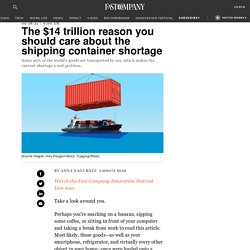
Most likely, those goods—as well as your smartphone, refrigerator, and virtually every other object in your home—once were loaded onto a large container in another country and traveled thousands of miles via ships crossing the ocean before ultimately arriving at your doorstep. Today, an estimated 90% of the world’s goods are transported by sea, with 60% of that—including virtually all of your imported fruits, gadgets, and appliances—packed in large steel containers. The Government Leader’s Field Guide to Organizational Agility: How to Navigate Complex and Turbulent Times (7 September 2021) by Sarah Miller and Shelley Kirkpatrick. Digital transformation in the travel industry. Few industries have suffered more at the hands of Covid-19 than international travel, which ground to a halt in early 2020 as borders closed and millions of people were ordered to stay at home.

Last year saw the sharpest annual decline in air traffic on record: passenger demand was down 65.9% on 2019’s total, according to the International Air Transport Association. The UN World Tourism Organization estimates that the economic impact on the industry in 2020 alone was $1tn (£710bn) – a loss that put about 120 million jobs at risk. Commercial Aerospace Insight Report. Recovery will be a long-haul flight Aerospace companies navigated a turbulent 2020, to say the least.
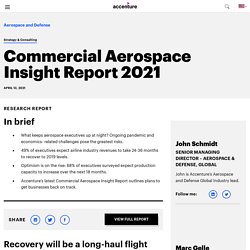
There’s no assurance of clear skies in 2021, but the forecast is improving as governments begin to ease restrictions and air travel regains momentum. According to Accenture’s Commercial Aerospace Insight Report, executives are cautiously optimistic about the future. Value-creation opportunities in digital for packaging companies. The COVID-19 pandemic has rapidly transformed the packaging industry in several ways, not least by accelerating the need for digital adoption, an area in which the industry has historically lagged.
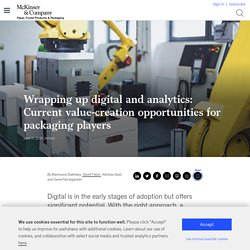
To understand the current state of play and the opportunity space for digital and analytics (DnA) in the industry, we launched a global survey with industry executives backed up by interviews with industry experts covering multiple packaging substrates and regions. Our work has uncovered four key findings.
First, the industry is, not surprisingly, still in the early days of digital adoption, lagging telecoms, banking, and advanced industries such as automotive and aerospace. However, according to executives in the surveyed packaging companies, DnA is a clear priority and is seen as an important value-creation lever. So far, the areas that are most advanced in terms of digital adoption are, in order, manufacturing, supply chain, and HR and talent management.
Introduction. Reimagining the Automotive Supply Chain. After heavy losses, tourism sector across the world is anxious to reopen. How Tech Adoption Fuels China’s Innovation Boom. CURT NICKISCH: Welcome to the HBR IdeaCast from Harvard Business Review.

I’m Curt Nickisch. A few weeks back, people in Shanghai’s downtown were surprised when a swarm of lights appeared in the night sky. They craned their necks watching these lights converge amid the skyscrapers forming a huge pattern. Now, this wasn’t a light show, as it turns out, or an alien invasion. It was a constellation of illuminated drones, and that swarm took shape as a giant QR code. Now outside of China, this marketing stunt might have really bothered people, too commercial, too invasive, too dystopian, but the willingness of consumers in China to engage with technology and new things, that’s what intrigues and inspires today’s guest. The rise of the Asian corporation. “The best time to plant a tree,” a Chinese proverb reminds us, “was 20 years ago.

The second best time is now.” Mining risk: Resiliency amid volatility. While COVID-19 has had a range of impacts on mining companies, varying by commodity and geography, the one thing the past year has taught leaders is the value of building resilient organizations to navigate uncertain futures.
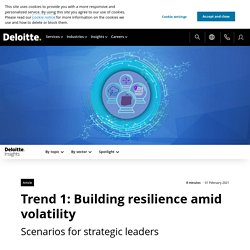
To build a resilient organization, mining companies should embrace scenario planning as part of their strategic planning processes. Doing this effectively can position miners to better anticipate a range of global disruptors that could affect their organizations. To help companies on this path, we outline four divergent scenarios based on current trends and uncertainties and consider how they might play out in the mining sector. How the pandemic transformed digital manufacturing.
In 2020, industrial digitization faced its biggest test to date.

Confronted with the largest health and economic crisis in recent history, companies across sectors were forced into extraordinary measures to protect their people and maintain operations. While some contended with keeping the operations running in the face of shortages of workers or raw materials, others struggled to keep up with the sudden spike in demand. Did the technologies of the ongoing Fourth Industrial Revolution (or Industry 4.0) help those companies in their efforts? Analysis of a new McKinsey survey’s results suggests three outcomes: a win for companies that had already scaled digital technologies, a reality check for those that were still scaling, and a wake-up call for those that hadn’t started on their Industry 4.0 journeys.
A path to recovery and sustainable growth in 10 industry sectors. Lessons from growth outperformers in logistics. The economic crisis caused by the COVID-19 pandemic has shone a spotlight on the critical value of global supply chains and the logistics companies that keep them moving.
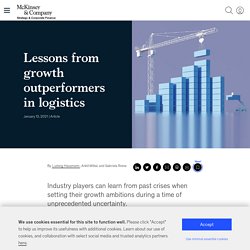
While the pandemic’s impact on the sector has been less severe than that on travel or transportation infrastructure players, market capitalization of logistics companies nevertheless declined by almost 3 percent between February and July. Logistics players rely on their global networks to achieve scale within a highly competitive and relatively low-margin industry. With trade demand plunging by as much as 22 percent in the second quarter and significant drops continuing in the third, many road-, air-, and ocean-transport companies are reporting large declines in volumes from the same periods last year.
Despite these challenges, the crisis presents opportunities for logistics firms to revisit their business models, enter new markets, and innovate around new service offerings. These modular ICU rooms turn hospital parking lots into COVID-19 units. Accelerating smart manufacturing. As COVID-19 necessitates greater agility and speed, leaders should consider engaging in smart manufacturing ecosystems to accelerate digital transformation and drive results in the next normal.
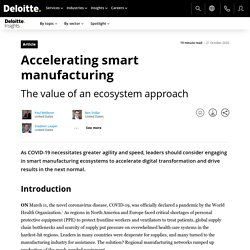
Introduction On March 11, the novel coronavirus disease, COVID-19, was officially declared a pandemic by the World Health Organization.1 As regions in North America and Europe faced critical shortages of personal protective equipment (PPE) to protect frontline workers and ventilators to treat patients, global supply chain bottlenecks and scarcity of supply put pressure on overwhelmed health care systems in the hardest-hit regions. Leaders in many countries were desperate for supplies, and many turned to the manufacturing industry for assistance. The solution? Regional manufacturing networks ramped up production of the much-needed equipment.
How manufacturing ecosystems accelerate production. How COVID-19 Will Change Retail — And What It Means for Brands. As the pandemic continues, retailers large and small are facing sweeping changes, unexpected obstacles, and intense leadership challenges amid COVID-19 and the end of the longest bull market in history. Many often look to past experiences to help determine a pathway for the future. Yet this method will not get retail leaders very far. The Uncertainty Mindset: Innovation Insights from the Frontiers of Food (28 July 2020) by Vaughn Tan. Abandoning Globalization Will Only Hurt U.S. Businesses. CitizenM Hotels: A blue ocean chain in a red ocean industry. By Chan Kim & Renée Mauborgne “If there ever were a red ocean,” observes Michael Levie, co-founder of CitizenM Hotels, “the hotel industry would be it. It’s redder than red.” Four-star hotels offer four-fifths of what five-star hotels offer. Three-star hotels offer three-quarters of what four-star hotels provide.
Declaration of interdependence: B Lab Global’s Andrew Kassoy. The first step to changing “the system” is to recognize that you’re a part of it. Effective leaders understand that there are myriad constituencies at play and that narrowing in on any one of them won’t work for long. Retooling Strategy for a Post-Pandemic World. Six months into one of the most challenging years in business history, simple clarity has become our most precious resource. Covid-19 is having a profound impact—we know that—but how it will play out remains deeply uncertain. While there’s no shortage of punditry and speculation, we’re still in the very early stages of understanding the pandemic’s full ramifications. Watch: How Tristan Walker Built a Multimillion-Dollar Brand Serving People of Color. Simon Sinek & Brian Chesky. Welcome to the Low Touch Economy. Building trust and personal connections in the Low Touch Economy. Not everything can be replaced via digital channels. A strategic framework for European economic recovery.
The Pandemic Is Rewriting the Rules of Retail. Executive Summary. How Businesses Have Successfully Pivoted During the Pandemic. Executive Summary. How disruption is reshaping construction. This article was a collaborative, global effort among Maria João Ribeirinho, Jan Mischke, Gernot Strube, Erik Sjödin, Jose Luis Blanco, Rob Palter, Jonas Biörck, David Rockhill, and Timmy Andersson. How growth can help Europe face the coming economic crisis. The great social imperative of the COVID-19 human crisis is the need to both save lives and protect livelihoods.
The threat to both has become increasingly clear: too many people are still suffering and dying—though, at this writing, according to the European Union Centre for Disease Prevention and Control, “the initial wave of transmission has passed its peak.” Driving a new generation of biological technologies. You start your day with a preworkout breakfast of synthetic eggs and lab-grown bacon, a diet tailored to your own genetic requirements. The Bio Revolution: Innovations transforming economies, societies, and our lives. The fashion industry’s digital transformation: Now or never. The COVID-19 pandemic is simultaneously an unprecedented health crisis and a global economic shock. Amid the pandemic, the apparel, fashion, and luxury (AF&L) industry has moved quickly to address urgent public-health needs—closing stores, manufacturing much-needed items such as face masks and hand sanitizer, and making donations to healthcare and community organizations.
Looking to the Future of Air Travel. Coronavirus: Airlines brace for severe turbulence. Apparel Retail Forever Changed: Moving Beyond COVID-19. We're Entering the Stay-Home Economy. Here are 10 Industries That Will Be Winners. MIT Published a List of the 9 Megatrends That Will Shape the World in 2030. Here's What They All Have in Common. 2019 health care industry leaders survey. Selon une agence gouvernementale, l'économie mondiale est proche de l'effondrement. 8 Best Industries for Starting a Business in 2020. 2020 Global 100 ranking (most sustainable corporations) Businesses are Thriving, Societies are Not. Time for Urgent Change. Three Predictions For Midsize Companies In 2020. Top 5 Challenges Automotive Industry Will Face In The 2020s.
Perspectives économiques 2020 pour le Canada. 2020 economic outlook for Canada. What can we expect in the Chinese economy in 2020? Manufacturing 2020. Top 10 most popular economics charts from the McKinsey Global Institute (2019) Technology, Media & Telecommunications Predictions 2020. Are Businesses Ready for Deglobalization? Parcel delivery. Gartner's Predictions for Retailers Show More Change Ahead. Comment les organisations informatiques les plus performantes se distinguent-elles des autres ? The State of Fashion 2020: Navigating uncertainty in the fashion industry.
Launched: FTI’s 2020 Entertainment, Media and Technology Trends Report. IBM Institute for Business Value. How traditional players can take on challenger banks. 2019 Digital Operations study for energy. 10 clés géopolitiques pour comprendre la Chine de Xi Jinping. Is There a Future for Service Stations? China and the world: Inside a changing economic relationship. Asia’s future is now. Government Trends 2020. China and the world: Inside a changing economic relationship. Tariffs And A Turkish Coup - How Manufacturers Win In The Face Of Uncertainty.
22nd CEO Survey: Transportation and logistics trends 2019. Industry Reports. 4 trends shaping the next generation of government. Organizational transformation for an agile telecom. Jabil’s manufacturing leap. Ensuring trust in an age of digital banking. Future of Banking 2019. The Future Today Institute. What is driving change in the events industry? Agile transformations in asset heavy industries. The future of health care. Nike launches a sustainability guide for designers. Personalisation through pay-as-you-live insurance is the future. Uber Quietly Changed Its Business Strategy to Focus on 1 Thing. The Most Effective Social Enterprises Understand the Power of the Individual - SPONSOR CONTENT FROM DELOITTE. Agile transformations in asset heavy industries. Technology push innovation in government. Future of banking: why retail banks have to go digital. Facing up to the automotive innovation dilemma. The future of manufacturing. To talk about agile transformation, let’s go to the movies.
Asian opportunities. Navigating a New Industrial Infrastructure. Conquering the Challenges of Agile at Scale in Government. Organizational transformation for an agile telecom. Prioritizing Long-Term Capabilities For Midmarket Growth. Governments must become as agile as startups. Here’s what they need to do. These 3 technologies will permanently change the banking sector.
Globalization in transition: The future of trade and global value chains. How China and the world can win together. What to expect in the Chinese Economy. The overlooked revolution for business in Africa.